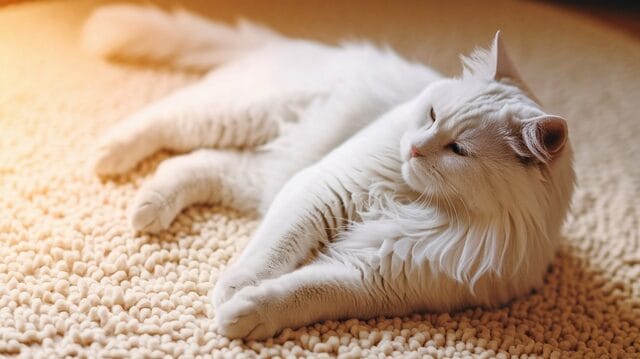
Introduction
Noticing bald spots on your cat? While shedding is completely normal, excessive hair loss or patchy bald spots can be a sign of an underlying issue. If you’ve been asking yourself, “Why is my cat losing hair?”, it could be due to allergies, parasites, stress, infections, or even medical conditions. Since cats are experts at hiding discomfort, their fur loss might be the only clue that something is wrong.
In this guide, we’ll cover 7 common causes of cat hair loss, how to identify them, and what you can do to help your furry friend get back to their healthy, fluffy self!
🐾 7 Common Causes of Cat Hair Loss & How to Treat Them

1. Allergies (Flea, Food, or Environmental) 🐜🌿🍗
Just like humans, cats can develop allergies to food, fleas, or environmental triggers (like pollen or dust mites). Allergies cause itching, excessive licking, and fur loss—especially around the belly, legs, and tail.
✔ Signs of Allergies:
- Constant scratching or licking.
- Red, irritated skin.
- Bald spots near the tail or belly.
✔ How to Treat It:
- Flea Allergies: Use vet-approved flea preventatives (like Revolution or Advantage).
- Food Allergies: Try a hypoallergenic diet (switch to novel proteins like duck or venison).
- Environmental Allergies: Use air purifiers and dust-free litter to reduce allergens.
🚨 When to See a Vet: If your cat’s fur loss continues despite treatment, allergy testing may be needed.
2. Parasites (Fleas, Mites, Ringworm) 🦠
Fleas, mites, and fungal infections like ringworm can cause patchy hair loss, extreme itchiness, and scaly skin.
✔ Signs of Parasites:
- Small red bumps or scabs.
- Excessive scratching and biting.
- Hair loss around the ears, face, or tail.
✔ How to Treat It:
- Fleas & Mites: Use flea control treatments and deep clean bedding.
- Ringworm: Requires antifungal medication (oral or topical).
🚨 When to See a Vet: If your cat’s fur loss is spreading or they seem uncomfortable, get a veterinary skin test.
3. Stress & Overgrooming (Psychogenic Alopecia) 😿
Cats sometimes groom excessively due to stress or anxiety, leading to bald patches on their belly, legs, and sides. This condition is called psychogenic alopecia.
✔ Signs of Stress-Related Fur Loss:
- Hair loss in areas they can reach with their tongue (belly, inner thighs).
- No visible redness or sores.
- Triggered by changes (new pets, moving, loud noises).
✔ How to Treat It:
- Reduce stress with interactive toys and a consistent routine.
- Use Feliway diffusers (calming pheromones for cats).
- Provide vertical spaces and safe hiding spots.
🚨 When to See a Vet: If overgrooming continues despite stress management, your vet may suggest anti-anxiety medication.
4. Skin Infections (Bacterial or Fungal) 🔬
If your cat’s hair loss is accompanied by redness, sores, or a bad odor, they may have a bacterial or fungal skin infection.
✔ Signs of Skin Infections:
- Bald patches with inflamed or crusty skin.
- Red bumps, pimples, or open sores.
- A bad smell from the affected area.
✔ How to Treat It:
- Antibiotics or antifungal medications (prescribed by a vet).
- Medicated shampoos to soothe the skin.
- Keeping your cat’s environment clean and free of irritants.
🚨 When to See a Vet: Skin infections don’t heal on their own—your vet will need to diagnose and treat the issue properly.
5. Hormonal Imbalances (Hyperthyroidism, Cushing’s Disease) 🏥
Certain hormonal disorders can cause fur thinning, dry skin, and excessive shedding.
✔ Common Conditions That Cause Hair Loss:
- Hyperthyroidism: Overactive thyroid leads to weight loss, increased appetite, and fur loss.
- Cushing’s Disease: Too much cortisol causes thinning fur and skin fragility.
✔ How to Treat It:
- Thyroid medication or special diets.
- Hormone-balancing treatments are recommended by a vet.
🚨 When to See a Vet: If hair loss is accompanied by weight changes, increased thirst, or behavior changes, it’s time for a checkup.
6. Poor Diet & Nutritional Deficiencies 🥩
A poor diet lacking in essential nutrients can lead to dry skin, a dull coat, and excessive shedding.
✔ Nutrients Essential for a Healthy Coat:
- High-quality protein (real meat sources like chicken or fish).
- Omega-3 & Omega-6 fatty acids (for skin health).
- Vitamins A, E, and Biotin (for strong hair follicles).
✔ How to Treat It:
- Switch to high-quality, protein-rich cat food (avoid fillers like corn or wheat).
- Add Omega-3 supplements (like salmon oil).
🚨 When to See a Vet: If your cat’s fur remains dull or brittle despite diet changes, a vet can check for absorption issues.
7. Genetic & Breed-Specific Hair Loss 🧬
Some cat breeds naturally have thin coats or patchy fur patterns, and their hair loss isn’t a health issue.
✔ Breeds Prone to Hair Loss:
- Sphynx (naturally hairless).
- Devon Rex & Cornish Rex (very thin fur).
- Burmese & Siamese (occasional seasonal fur thinning).
✔ How to Manage It:
- Use gentle grooming (soft brushes for sensitive skin).
- Keep their skin moisturized with vet-approved lotions.
🚨 When to See a Vet: If a normally fluffy breed suddenly develops bald spots, it could indicate a medical issue.
🐾 When to See a Vet for Cat Hair Loss
🚨 While some fur loss is normal, these signs mean it’s time for a vet visit:
- Large bald patches or rapidly worsening fur loss.
- Red, inflamed, or infected skin.
- Excessive scratching, biting, or licking.
- Weight loss, changes in appetite, or unusual behavior.
🙋 FAQs: Cat Hair Loss Explained
Q1: Is it normal for cats to shed a lot?
✔ Yes, but excessive shedding or bald spots are not normal.
Q2: Can stress really make my cat lose fur?
✔ Yes! Stress-induced overgrooming (psychogenic alopecia) is a real condition.
Q3: How can I improve my cat’s coat health?
✔ Feed a balanced diet, brush regularly, and provide flea prevention.
Q4: Can home remedies help with cat hair loss?
✔ Only in mild cases—always consult a vet first for serious issues.
Also Read - How to Train Your Cat to Walk on a Leash? Step-by-Step Guide
Final Thoughts: Keep Your Cat’s Coat Healthy & Full
Hair loss in cats isn’t just a cosmetic issue—it can signal underlying health problems. Identifying the cause early can prevent serious medical conditions and keep your feline happy and fluffy.
🐱 Now It’s Your Turn!
Has your cat experienced fur loss? Share your story in the comments below! 👇🐾




